The common causes of an AC not blowing cold air are refrigerant leaks, thermostat problems, dirty air filters, blocked/closed air vents, clogged drain line, frozen evaporator coil, dirty condenser coil, leaking air ducts or power issues. Sometimes it could be failed components like the compressor or fan motors.

Common Causes
- Dirty or Clogged Air Filters: Dirty filters can restrict airflow, making it difficult for the AC to cool the air effectively.
- Refrigerant Issues: Low refrigerant levels due to leaks or improper charging can result in insufficient cooling.
- Frozen Evaporator Coils: Ice formation on the evaporator coils can impede heat exchange and cooling.
- Thermostat Settings: Incorrect thermostat settings, such as a high temperature setting or the “fan” set to “on,” can lead to inadequate cooling.
- Condenser Unit Problems: A dirty or blocked condenser unit can hinder heat dissipation.
- Compressor Malfunction: A malfunctioning compressor may struggle to circulate refrigerant, affecting cooling.
- Electrical Issues: Faulty capacitors, relays, or wiring can disrupt the AC’s operation.
- Ductwork Problems: Leaks, gaps, or blockages in the ductwork can reduce cold air delivery.
- Frozen Condenser Unit: Ice buildup on the condenser unit can obstruct airflow and cooling.
- System Size: An improperly sized AC unit may not be able to adequately cool your space.
What to Do
- Change or Clean Air Filters: Replace or clean dirty air filters to improve airflow and cooling efficiency.
- Check for Refrigerant Leaks: Have a professional technician inspect and repair any refrigerant leaks and recharge the system.
- Thaw Frozen Components: Turn off the AC to let frozen components like the evaporator coils or condenser unit thaw, addressing the underlying issue causing the freezing.
- Adjust Thermostat Settings: Set the thermostat to the desired temperature and ensure the fan is set to “auto” for efficient cooling.
- Clean the Condenser Unit: Remove debris and dirt from the condenser unit to optimize heat dissipation.
- Compressor Evaluation: Have a technician assess the compressor’s condition and replace it if necessary.
- Inspect Electrical Components: Check capacitors, relays, and wiring for issues and replace any faulty components.
- Ductwork Inspection: Seal leaks and gaps, and remove obstructions in the ductwork to improve cold air delivery.
- Defrost Frozen Components: In cases of ice buildup, use a gentle heat source or allow time for defrosting.
- Consider System Size: Consult an HVAC professional to assess your AC unit’s size and determine if an upgrade is needed for better cooling performance.
Let us now look at the many reasons why your AC is not blowing cold air in the house in more details.
1. Thermostat Problems
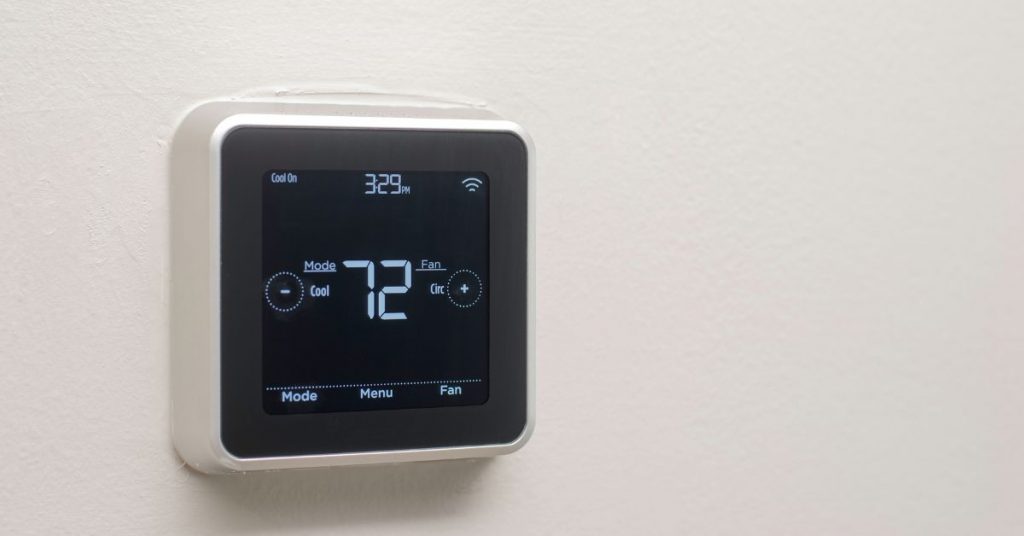
The thermostat is the command center of your HVAC system. It monitors the temperature inside your house and tells the AC when to start and when to turn off. For it to do that though, the AC needs to be properly set.
Depending on the type of thermostat you have, you should be able to see whether it is telling the system to cool or heat the house. Remember that the thermostat controls the AC and the furnace or heat pump as well.
As such, you should see that the thermostat is set to “cool”. After that, set the thermostat temperature to 5 degrees lower than the room temperature. Check if that fixes the problem.
If you have a programmable thermostat, press the “HOLD” button which should also appear next to the temperature you have set. That is usually a command which overrides other thermostat setting, meaning that the AC will cool the house to the set temperature.
You may also need to change your thermostat batteries. When the batteries are depleted or almost getting depleted, the thermostat may fail to send the correct command to the AC and as a result no cold air will be blown in the house.
Look for clips on the thermostat which secures it in place, press them in and slide out the thermostat. You will find the old batteries at the back or side of the thermostat. Not all thermostats have batteries though, so don’t be surprised if your thermostat has none.
A good sign that your thermostat batteries are dead is when the thermostat is blank.
If you have a relatively new air conditioner that is not blowing cold air, it is very likely that the thermostat was not properly wired. As such, the thermostat sends wrong commands to the AC unit and therefore no cold air is being blown in the house.
To fix bad thermostat connections is not an easy DIY. You should contact an HVAC technician to come over and fix it. The person who did the faulty job should do it again for free.
2. Power Supply Issues

Needless to say, your air conditioner needs power to run. That will be 240 volts for central and big ductless systems or 120 volts for small units. Sometimes there will be no cold air being supplied in your house because the AC is not being supplied with power.
The first thing you should check is the circuit breaker panel inside your house. Has the AC breaker tripped? In case of an overload, AC systems are designed to trip the breaker, thereby cutting power supply to the unit.
If the circuit breaker has tripped, flip it back to the “ON” position. Sometimes that is all you may need to do. If the breaker trips again, there is an underlying problem with your AC that you need to fix.
The breaker trips when the AC circuits overloads, usually due to the following reasons, which can make the AC components overheat and burn out:
- Power surge
- Lightning strikes
- Dirty filters
- Clogged ductwork or vents
- Dirty condenser coils
- Leaking refrigerant
- Frozen evaporator coil
- Damaged AC motors
Central ACs also have fuses on the wall next to the outside unit which can blow, to prevent damage to the unit. To check if that is the case, turn off power to the AC and test the fuses for continuity.
If the fuses fail the continuity test, replace them with new similar ones. While at it, inspect the power cord from the wall to the outside unit.
It is not unusual for rodents to chew up the cable insulations leaving the wires exposed/naked. It is also good to make sure that the AC is properly plugged in the power outlet and that both the outside and inside AC switch (located next to the furnace) are not turned off.
3. Dirty Air Filter
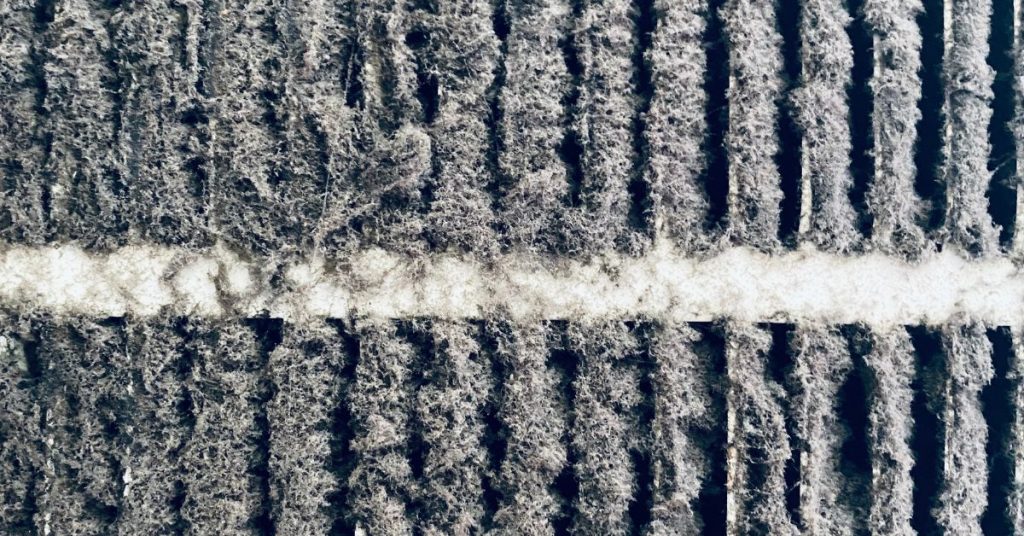
Apart from cooling the indoor air, an air conditioner is also responsible for cleaning the air. As such, air conditioners are fitted with an air filter to remove dust, lint, pollen and other impurities from the air.
Central air systems have return and supply air ducts (and vents/registers). Return air ducts pull warm air from the house through the return vents and direct it to the evaporator coil for cooling. Supply air ducts then circulate the cold air in the house through the supply vents/registers.
AC filters are therefore located in the return air ducts so that the can clean the air before it gets to the evaporator coil. That prevents the coil from being damaged by the dirt.
Ideally, you should replace the AC filter after every 3 months. You would however be surprised by the number of people who have never changed their AC filters.
Failing to change your AC/furnace filter causes it to be clogged by dirt, restricting the flow of air to the evaporator coil. If the evaporator coil cannot receive enough air to cool, there will also be insufficient cold air being blown in the house.
Fortunately, replacing an AC filter is easy and filters are generally inexpensive. Be sure to buy the correct MERV rating for your AC. A filter with a MERV rating of 8 to 12 will be good for residential applications.
The first thing you will need to do is locate your air filter. Air filters are generally located in 2 areas:
- In your living area just behind the return vent grille. To tell which one is the return or supply vent, place your palm close to the vent. You should feel a suction force if it is a return vent.

- Next to the furnace where the return vent is connected, there should be an air filter slot. In vertical HVAC units that will be at the bottom while in horizontal systems the return will be on the side of the furnace.
Once you find the filter, turn off power to the AC before removing it to prevent the dust from being pulled in towards the coil.
The second thing you need to be careful about when replacing your AC filter is the size. All AC filters sizes are not standard. Check the correct size of the AC filter by checking the side of the old filter. It will be written there. Purchase an exact same size of filter.
When installing the new filter, you need to be very careful of the direction in which you put it in. There will be an arrow on the side of the filter. The arrow should point towards the furnace/evaporator coil and away from the return air duct.
If a dirty AC filter was the problem, the AC should now start blowing cold air in the house again.
4. Leaking Refrigerant
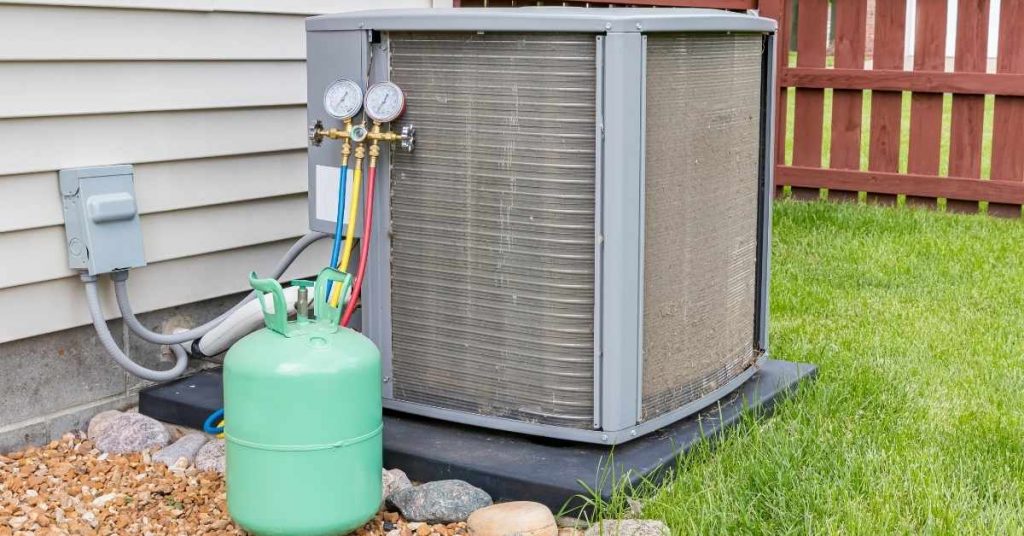
An AC refrigerant (commonly known as Freon even though Freon has been phased out) is responsible for cooling your house. It exists inside your AC system either as a gas or a liquid.
When it enters the evaporator coil inside the house, it is in the form of a cold liquid which then absorbs heat from the indoor air, cooling it in the process. Due to its low boiling point, it evaporates and enters the compressor coil where it is compressed to increase its temperature and pressure.
From the compressor the refrigerant enters the condenser coil where it releases the heat to the outdoor air. The condenser fan helps it to do so by blowing cooler air over the coil thereby increasing the rate of heat exchange.
For the air conditioner to cool your house properly, the amount of refrigerant in the system needs to be just right (determined by checking its pressure). If there isn’t enough refrigerant in the system, the warm air from the house will not be cooled to the desired levels and as a result you will notice not enough cool air being blown in the house.
Contrary to popular belief, you don’t need to regularly top up your AC with a refrigerant. The cooling system is a sealed/close-looped system and the refrigerant doesn’t get depleted. It only changes from one state to another.
If the refrigerant level in your AC system is low, it means that you have a leak somewhere in your system.
Unfortunately, checking refrigerant levels and recharging the system is not something homeowners can or should do on their own. It is a job best left to licensed HVAC technicians.
5. Blocked or Closed Registers/Vents

As I mentioned, warm air from the house enters the return air ducts through the return vents while cold air enters the house through the supply vents. If the vents are closed or blocked, air will not circulate in the house and as result you will have no cold air being blown in the house.
Blocked or clogged air vents have the same effect as clogged air filters. They restrict the movement of air from and to the house.
Start by checking if your vents are closed. It is common for people to close vents especially when they want to send cold air to a certain room in the house. If that is the case open them.
Blocked vents (either by objects or dirt) should also be unblocked. Start by removing the grille either by pulling the clips or in some cases removing the screws with a screwdriver.
Use your hand to try and pull out clogs inside the ductwork (usually the clogs are not far from the vent). Be very gentle to prevent damaging the ductwork and also avoiding using any sharp objects.
If the vents are on the wall, leave sufficient spaces between them and other objects like furniture. That will allow the cold air to flow out freely without being obstructed.
Tip: If you have HVAC dampers in your house, make sure that they are open. Closed dampers will shut off the supply of cold air to the respective air vents.
6. Leaking Ductwork
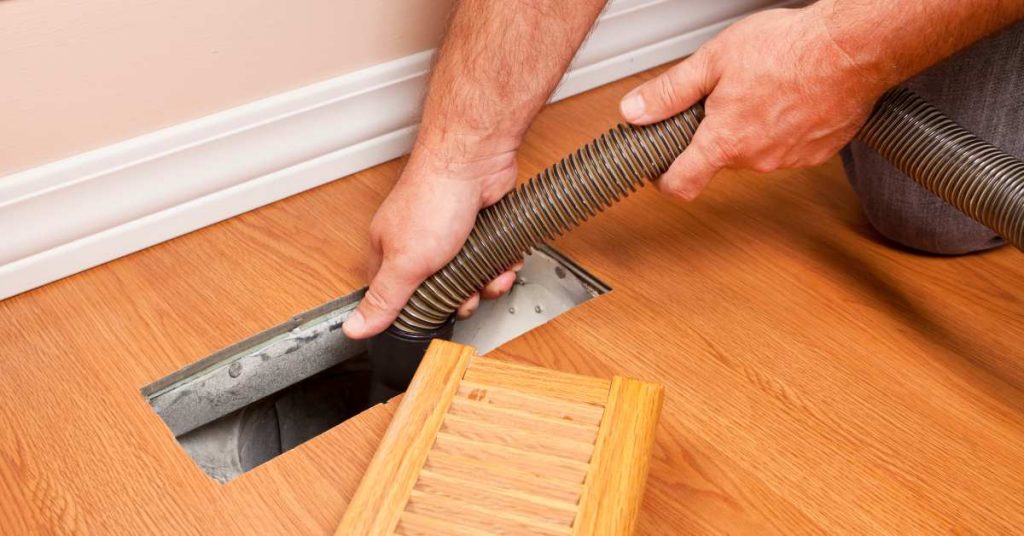
Central air ductwork leak all the time. If you have a very bad leak, either warm air from the house will not get to the evaporator coil for cooling or cooled air from the evaporator coil will not be supplied to the house.
If for instance the supply air duct is leaking out the cold air in the attic, you will have no cold air being blown in your house. Clogged or even collapsed air ducts will also have the same effect.
Although you can try to trace you ductwork from the indoor unit backwards looking for leaks, it is not an easy job and you may not know or have the proper tools to fix it. Again, this is a job which should be left to the professionals.
7. Clogged AC Drain Line
Air Conditioners are also responsible for reducing the humidity in the house apart from cooling the indoor air. When the warm and humid indoor air comes into contact with the evaporator coil, the moisture in the air condenses and drips in the condensate drain pan located under the coil.
The condensate drain pain is also connected to the AC drain line, which drains the condensate outside. For perspective purposes, a big AC unit can produce up to 20 gallons of condensate in a day.
Due to the humid nature inside the drain line, algae thrive there and will after sometime multiply and clog the line. With the line clogged, the drip pan will continue filling with water but the line won’t drain it.
To prevent the pan from overflowing, a float switch is installed there will automatically turn off the thermostat if the water level reaches a certain point. With the thermostat turned off, no more condensate will be produced, but importantly no cold air will be blown in the house.
The solution here, which is an easy one is to unclog the drain line. Look for a plastic tee with a cap near the AC’s condensate drain pan. Remove the cap and use a thin drain snake to clear the drain line.
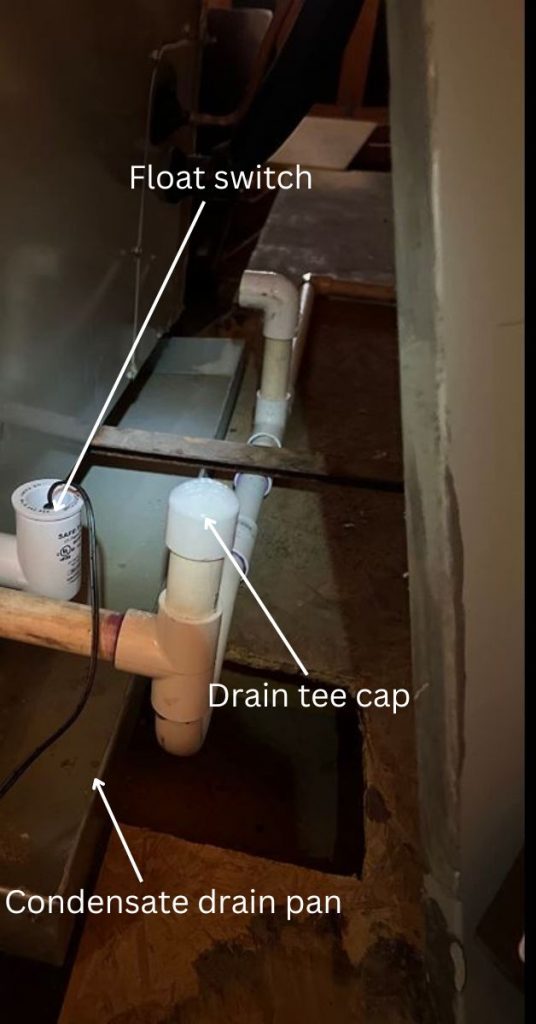
Alternatively, pouring vinegar down the tee will break down the clog and clear the drain line. If you want to remove the clog quickly, connect a shop vacuum’s hose to the AC drain line outside the house and suck the clog out in a minute or less.
Cleaning the AC drain line regularly is a sure way to prevent it from clogging.
8. Dirty Condenser Coil
During the cooling cycle, the refrigerant enters the condenser coil carrying the heat absorbed from the indoor air. It needs to lose that heat to the surrounding and go back inside for another round of cooling.
Therefore, the condenser fan pulls air from the surrounding and forces it across the coils where it absorbs the heat and then blows it to the surrounding. In the process, the condenser coil fins (looks like those of a car’s radiator) gets clogged with debris from the surrounding.
A dirty evaporator coil thereby restricts the flow of air to the surrounding, meaning that the heat exchange between the refrigerant and air becomes hard. As a result, the cooling process is slowed down considerably which could be the reason there is no cold air being blown in the house.
Note: A dirty condenser coil also causes hot air to be trapped inside the condenser unit. This can result in overheating of the motors or capacitors, which may end up failing.
To fix this problem, you can clean the condenser coil yourself or have a professional come over and do it for you. This is how to clean an AC condenser unit:

- Turn off power to the AC
- Remove the outside AC panels (front, back and sides). You will need a screwdriver or cordless drill.
- Use a brush with soft bristles to remove the debris from the fins. Always brush from top to bottom but not sideways.
- Use a hose with a spray nozzle to clean the coil. Again, spray from the top downwards.
- Put back the panels and turn on the AC.
9. Dirty Evaporator Coil
Even though your AC has an air filter, some debris will still manage to pass through it and embed on the evaporator coil. Continued deposits of the debris prevent the refrigerant from cooling the indoor air and you will end up with an AC not blowing cold air in the house.
Usually, an HVAC technician should clean the evaporator coil during the annual HVAC maintenance. Most do not do it though.
Luckily, you can inspect and clean an evaporator coil on your own. You may need to buy a coil clean from a hardware store though it is not always needed.
The first thing you will need to do is turn of power to the AC at the main breaker panel in the house. After that disconnect the covers to access the coil. Start by cleaning it using the brush then use the coil cleaner and a vacuum.
I found the video below quite helpful when it comes to cleaning AC evaporator coils.
10. Damaged AC Motors
An AC system has 3 motors:
- Blower motor
- Condenser fan motor
- Compressor motor
The blower motor is located inside the house with the indoor unit and is responsible for pulling warm air from the house and blowing the cold air back in the house. If the blower motor is faulty (sometimes could be the fan blades), there AC won’t blow cold air in the house.
Apart from no cold air, the following are the other signs of a bad blower motor:
- Strange noise (grinding, screeching and vibrations) coming from the unit
- Circuit breaker keeps tripping
- Burning smell coming from the vents
- High energy bills
If the blower motors seems to work just fine, dash out to the outside unit. Can you hear funny groaning, clattering or even grinding noises? The compressor motor could be dead or dying. A bad compressor motor will also cause the circuit breaker to keep tripping.
Also, check if the condenser fan is spinning. If the outside unit is buzzing but the fan is not spinning, you either have a bad fan motor or a failed capacitor.
Just to be sure, manually try to turn the fan using a screwdriver or stick (clockwise direction) through the grille at the top.
If the fan kicks in and starts spinning as it normally should, you have a failed capacitor. Check out this post on how to test and replace an AC capacitor.
On the other hand, if the fan fails to keep on spinning, you most likely have a faulty fan motor. It could also be debris in the fan axle or bearing, preventing the fan from spinning. In old units, a broken or snapped belt could be to blame.
If you have a problem with any of you AC motors, turn off the AC and call in a licensed HVAC technician. Sometimes a repair may fix the problem but most of the time you may need to replace the motor or even the whole unit.
11. Frozen AC Coil
Check if the evaporator coil is frozen. The evaporator coil freezes when the temperature of the refrigerant falls below freezing point.
A frozen evaporator coil is caused by one of the following reasons:
- Low refrigerant levels
- Dirty air filter
- Clogged/leaking ducts
- Dirty evaporator coil
- Faulty blower
When the evaporator coil freezes, the refrigerant cannot absorb heat from the warm air. As a result, you will have no cold air being blown in your house.
While you can turn off the AC and wait for the ice to thaw, that is not the solution to your problem. You need to find out why the coil froze in the first place and fix that problem. Most of the time the problem is usually leaking refrigerant.
Wrap Up
And basically those are the reasons why there is no cold air being blown by the AC in your house. As you have seen, some problems can easily be fixed while others will need to be taken care of by a professional.
